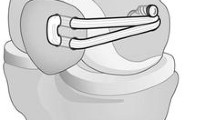Abstract
The aim of this study was to assess the clinical outcome of popliteofibular ligament (PFL) reconstruction for posterolateral external rotation instability of the knee. PFL reconstruction was performed consecutively in 22 patients with chronic external rotation instability of the knee. The inclusion criterion for surgery was tibial external rotation of 10° more than the contralateral uninjured knee without varus laxity. A double bone tunnel was created at the PFL insertion of the fibular head through the lateral incision of the knee joint and a single bone tunnel at the popliteus tendon insertion on the femoral side. A semitendinosus autograft tendon or tibialis anterior allograft tendon was introduced through the fibular tunnel as a loop, then both free ends of the graft were introduced through the femoral tunnel and a bioabsorbable interference screw was used to fix the graft. The minimum follow-up was 2 years. Clinical review included the International Knee Documentation Committee (IKDC) scale and tibial external rotation assessment. All patients’ preoperational tibial external rotation averaged 15° more than the contralateral uninjured knee. operatively the tibial external rotation was decreased, average −3° compared with the contralateral side. This difference was statistically significant. The final IKDC grades were: 22 cases with grade D preoperatively, and 6 were grade A, 8 were grade B, 7 were grade C and 1 was grade D postoperatively. In this small clinical series, PFL reconstruction technique was shown to correct pathological excessive tibial external rotation.







Similar content being viewed by others

References
Albright JP, Brown AW (1998) Management of chronic posterolateral rotatory instability of the knee: surgical technique for the posterolateral corner sling procedure. Instr Course Lect 47:369–378
Apsingi S, Nguyen T, Bull AM, Unwin A, Deehan DJ, Amis AA (2008) Control of laxity in knees with combined posterior cruciate ligament and posterolateral corner deficiency: comparison of single-bundle versus double-bundle posterior cruciate ligament reconstruction combined with modified Larson posterolateral corner reconstruction. Am J Sports Med 36:487–494
Arciero RA (2005) Anatomic posterolateral corner knee reconstruction. Arthroscopy 21:1147e1–1147e5
Csintalan RP, Ehsan A, McGarry MH, Fithian DF, Lee TQ (2006) Biomechanical and anatomical effects of an external rotational torque applied to the knee: a cadaveric study. Am J Sports Med 34:1623–1629
Fanelli GC (2006) Surgical treatment of lateral posterolateral instability of the knee using Biceps tendon procedures. Sports Med Arthrosc Rev 14:37–43
Fanelli GC, Edson CJ (2004) Combined posterior cruciate ligament–posterolateral reconstructions with Achilles tendon allograft and biceps femoris tendon tenodesis: 2- to 10-year follow-up. Arthroscopy 20:339–345
Fanelli GC, Larson RV (2002) Practical management of posterolateral instability of the knee. Arthroscopy 18:1–8
Fanelli GC, Feldmann DD (1999) Management of combined ACL/PCL/posterolateral complex injuries of the knee. Oper Tech Sports Med 7:143–149
Harner CD, Vogrin TM, Hoher J, Ma CB, Woo SL (2000) Biomechanical analysis of a posterior cruciate ligament reconstruction: deficiency of the posterolateral structures as a cause of graft failure. Am J Sports Med 28:32–39
Hughston JC, Norwood LA (1980) The posterolateral drawer test and external rotational recurvatum test for posterolateral rotatory instability of the knee. Clin Orthop Relat Res 147:82–87
Ishigooka H, Sugihara T, Shimizu K, Aoki H, Hirata K (2004) Anatomical study of the popliteofibular ligament and surrounding structures. J Orthop Sci 9:51–58
Khanduja V, Somayaji HS, Harnett P, Utukuri M, Dowd GS (2006) Combined reconstruction of chronic posterior cruciate ligament and posterolateral corner deficiency A two- to nine-year follow-up study. J Bone Joint Surg Br 88:1169–1172
LaPrade RF, Ly TV, Wentorf FA, Engebretsen L (2003) The posterolateral attachments of the knee: a qualitative and quantitative morphologic analysis of the fibular collateral ligament, popliteus tendon, popliteofibular ligament, and lateral gastrocnemius tendon. Am J Sports Med 31:854–860
LaPrade RF, Tso A, Wentorf FA (2004) Force measurements on the fibular collateral ligament, popliteofibular ligament, and popliteus tendon to applied loads. Am J Sports Med 32:1695–1701
LaPrade RF, Wentorf F (2002) Diagnosis and treatment of posterolateral knee injuries. Clin Orthop Relat Res 402:110–121
Lee MC, Park YK, Lee SH, Jo H, Seong SC (2003) Posterolateral reconstruction using split Achilles tendon allograft. Arthroscopy 19:1043–1049
Markolf KL, Graves BR, Sigward SM, Jackson SR, McAllister DR (2007) Popliteus bypass and popliteofibular ligament reconstructions reduce posterior tibial translations and forces in a posterior cruciate ligament graft. Arthroscopy 23:482–487
McGuire DA, Wolchok JC (2003) Posterolateral corner reconstruction. Arthroscopy 19:790–793
Pasque C, Noyes FR, Gibbons M, Levy M, Grood E (2003) The role of the popliteofibular ligament and the tendon of popliteus in providing stability in the human knee. J Bone Joint Surg Br 85:292–298
Sekiya JK, Kurtz CA (2005) Posterolateral corner reconstruction of the knee: surgical technique utilizing a bifid Achilles tendon allograft and a double femoral tunnel. Arthroscopy 21:1400.e1–e5
Strobel MJ, Schulz MS, Petersen WJ, Eichhorn HJ (2006) Combined anterior cruciate ligament, posterior cruciate ligament, and posterolateral corner reconstruction with autogenous hamstring grafts in chronic instabilities. Arthroscopy 22:182–192
Tzurbakis M, Diamantopoulos A, Xenakis T, Georgoulis A (2006) Surgical treatment of multiple knee ligament injuries in 44 patients: 2–8 years follow-up results. Knee Surg Sports Traumatol Arthrosc 14:739–749
Wentorf FA, LaPrade RF, Lewis JL, Resig S (2002) The influence of the integrity of posterolateral structures on tibiofemoral orientation when an anterior cruciate ligament graft is tensioned. Am J Sports Med 30:796–799
Yoon KH, Bae DK, Ha JH, Park SW (2006) Anatomic reconstructive surgery for posterolateral instability of the knee. Arthroscopy 22:159–165
Zhao J, He Y, Wang J (2006) Anatomical reconstruction of knee posterolateral complex with the tendon of the long head of biceps femoris. Am J Sports Med 34:1615–1622
Author information
Authors and Affiliations
Corresponding author
Rights and permissions
About this article
Cite this article
Zhang, H., Feng, H., Hong, L. et al. Popliteofibular ligament reconstruction for posterolateral external rotation instability of the knee. Knee Surg Sports Traumatol Arthrosc 17, 1070–1077 (2009). https://doi.org/10.1007/s00167-009-0794-0
Received:
Accepted:
Published:
Issue Date:
DOI: https://doi.org/10.1007/s00167-009-0794-0



